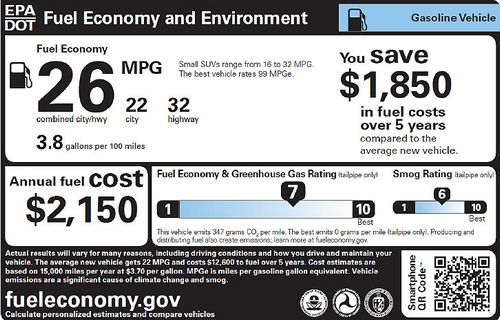
| Monday, June 06, 2011 | Archives | Advertise | Online Buyer's Guide | FLEETSolutions |
Environmental Protection Agency, Department Of Transportation Unveil The Next Generation Of Fuel Economy Labels
 The U.S. Department of Transportation and the U.S. Environmental Protection Agency unveiled new fuel economy labels on May 25 that will help consumers take advantage of the increased efficiency standards achieved under the Obama Administration, expected to save families money at the pump starting this year. The new labels, which are the most dramatic overhaul to fuel economy labels since the program began more than thirty years ago, will provide more comprehensive fuel efficiency information, including estimated annual fuel costs, savings, as well as information on each vehicle's environmental impact. The new labels underscore the benefits of the passenger car and truck fuel economy rule adopted under this administration by the EPA and DOT in 2010. These improvements are expected to give consumers better, more complete information to consider when purchasing new vehicles that are covered by the increased fuel economy standards. Starting with model year 2013, the improved fuel economy labels will be required to be affixed to all new passenger cars and trucks – both conventional gasoline powered and "next generation" cars, such as plug-in hybrids and electric vehicles. Upon taking office, President Obama directed DOT and EPA to prioritize the development of new fuel efficiency and greenhouse gas emissions standards, resulting in the standards that will be represented by these new labels. This is the latest step in EPA's and DOT's joint efforts to improve the fuel economy and environmental performance of vehicles, and to provide consumers with useful information to inform their purchasing decisions. The 2010 fuel economy rule, developed with input from major automakers, environmental groups, and the states, will increase the energy efficiency of cars and trucks built in model years 2012 through 2016, saving 1.8 billion barrels of oil over the life of the program, and the average consumer $3,000 in fuel costs. In July, the administration plans to finalize the first-ever national fuel economy and greenhouse gas emission standards for commercial trucks, vans, and buses built in 2014 to 2018. These standards are expected to promote the development and deployment of alternative fuels, including natural gas. The administration is also developing the next generation of joint fuel economy/greenhouse gas emission standards for model year 2017-2025 passenger vehicles, and expects to announce the proposal in September 2011. The new labels are proposed to help consumers take advantage of the new, more energy efficient fleet, allowing them to save money at the pump. Consumers will see the new labels in showrooms early next year, when 2013 models begin arriving. Automakers may also voluntarily adopt the new labels earlier for model year 2012 vehicles. The new labels will, for the first time, provide:
Consumers can get more information about the new label at: www.fueleconomy.gov More information on the new label can be found at: www.epa.gov/otaq/carlabel/index.htm and www.nhtsa.gov/fuel-economy |
 |
NAFA Fleet Management Association 125 Village Blvd., Suite 200 Princeton, NJ 08540 Telephone: 609.720.0882 Fax: 609.452.8004 |






